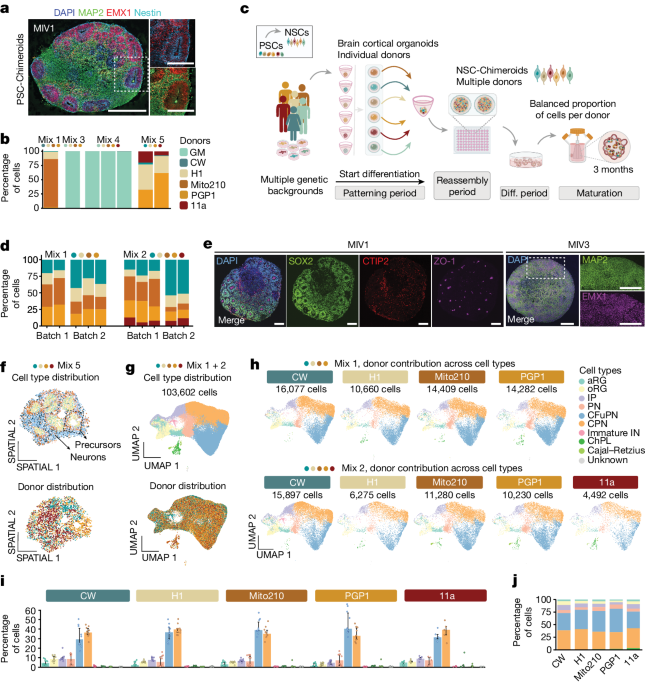insight - Computational Biology - # Interindividual Variation in Neurotoxin Susceptibility using Brain Chimeroids
Human Brain Chimeroids Reveal Individual Susceptibility to Neurotoxic Triggers
Core Concepts
Interindividual genetic variation affects susceptibility to and progression of many diseases, but studying how individual human brains differ in normal development and disease phenotypes is limited. Brain Chimeroids, a multidonor human brain cortical organoid model, can be used to investigate interindividual variation in susceptibility to neurotoxic triggers.
Abstract
The article presents a novel human brain organoid model called "Chimeroids" that can be used to study interindividual variation in brain development and disease phenotypes. Chimeroids are generated by co-developing cells from multiple individual donors in a single organoid, allowing each donor's cells to produce all cell lineages of the cerebral cortex.
The researchers used Chimeroids to investigate how individual donors vary in their susceptibility to neurotoxic triggers, such as ethanol and the antiepileptic drug valproic acid. They found that individual donors exhibited differences in both the penetrance of the effect on target cell types and the molecular phenotype within each affected cell type.
These results suggest that human genetic background may be an important mediator of neurotoxin susceptibility. The Chimeroids model provides a scalable system for high-throughput investigation of interindividual variation in brain development and disease processes, overcoming the limitations of current cellular models.
Brain Chimeroids reveal individual susceptibility to neurotoxic triggers - Nature
Stats
Interindividual genetic variation affects the susceptibility to and progression of many diseases.
Current systems for studying individual human brain differences are limited by the paucity of faithful cellular human models and the difficulty of scaling to represent multiple people.
Quotes
"Here we present human brain Chimeroids, a highly reproducible, multidonor human brain cortical organoid model generated by the co-development of cells from a panel of individual donors in a single organoid."
"We used Chimeroids to investigate interindividual variation in the susceptibility to neurotoxic triggers that exhibit high clinical phenotypic variability: ethanol and the antiepileptic drug valproic acid."
Key Insights Distilled From
by Noel... at www.nature.com 06-26-2024
https://www.nature.com/articles/s41586-024-07578-8
Deeper Inquiries
How can the Chimeroids model be further developed and applied to study other neurological disorders with high interindividual variability?
The Chimeroids model can be enhanced by incorporating a wider range of donor cells to capture a more diverse genetic background, thus increasing the representation of human genetic variability. This can be achieved by expanding the donor pool to include individuals with specific genetic mutations or disease susceptibilities relevant to the neurological disorder being studied. Additionally, optimizing the culture conditions and differentiation protocols to better mimic the cellular composition and organization of the human brain will improve the model's relevance to studying neurological disorders with high interindividual variability. Furthermore, integrating advanced imaging techniques and single-cell sequencing technologies can provide a more detailed characterization of the cellular and molecular differences among individual donors, enabling a deeper understanding of disease mechanisms and potential therapeutic targets.
What are the potential limitations or challenges in using Chimeroids to accurately represent the complexity of the human brain and its response to neurotoxins?
One potential limitation of using Chimeroids is the complexity of recreating the intricate cellular interactions and structural organization present in the human brain. While Chimeroids can capture some aspects of this complexity by incorporating multiple cell types and donor cells, the model may still lack the full spectrum of cell-cell interactions and spatial organization found in the human brain. Additionally, the scalability of the Chimeroids model may pose a challenge in accurately representing the diverse responses of individual brains to neurotoxins, as scaling up the model to include a larger number of donors may introduce technical difficulties and variability in the experimental outcomes. Moreover, the reproducibility and standardization of the Chimeroids model across different laboratories and experimental conditions could be a potential challenge in ensuring consistent and reliable results for studying the response of the human brain to neurotoxins.
What other types of cellular or organoid models could be combined with the Chimeroids approach to provide a more comprehensive understanding of individual susceptibility to brain diseases and environmental factors?
To complement the Chimeroids approach and enhance the understanding of individual susceptibility to brain diseases and environmental factors, other cellular or organoid models can be integrated. For instance, incorporating induced pluripotent stem cell (iPSC)-derived neuronal cultures from individual donors can provide a more specific and detailed analysis of neuronal responses to neurotoxins within the Chimeroids model. Furthermore, incorporating microfluidic systems or organ-on-a-chip platforms can enable the simulation of dynamic physiological conditions and interactions between different brain regions, offering a more holistic view of the effects of neurotoxins on the human brain. Additionally, combining the Chimeroids model with three-dimensional (3D) bioprinting technologies can facilitate the generation of complex brain tissue structures with precise spatial organization, allowing for a more accurate representation of the human brain's response to environmental factors and disease processes.
0
